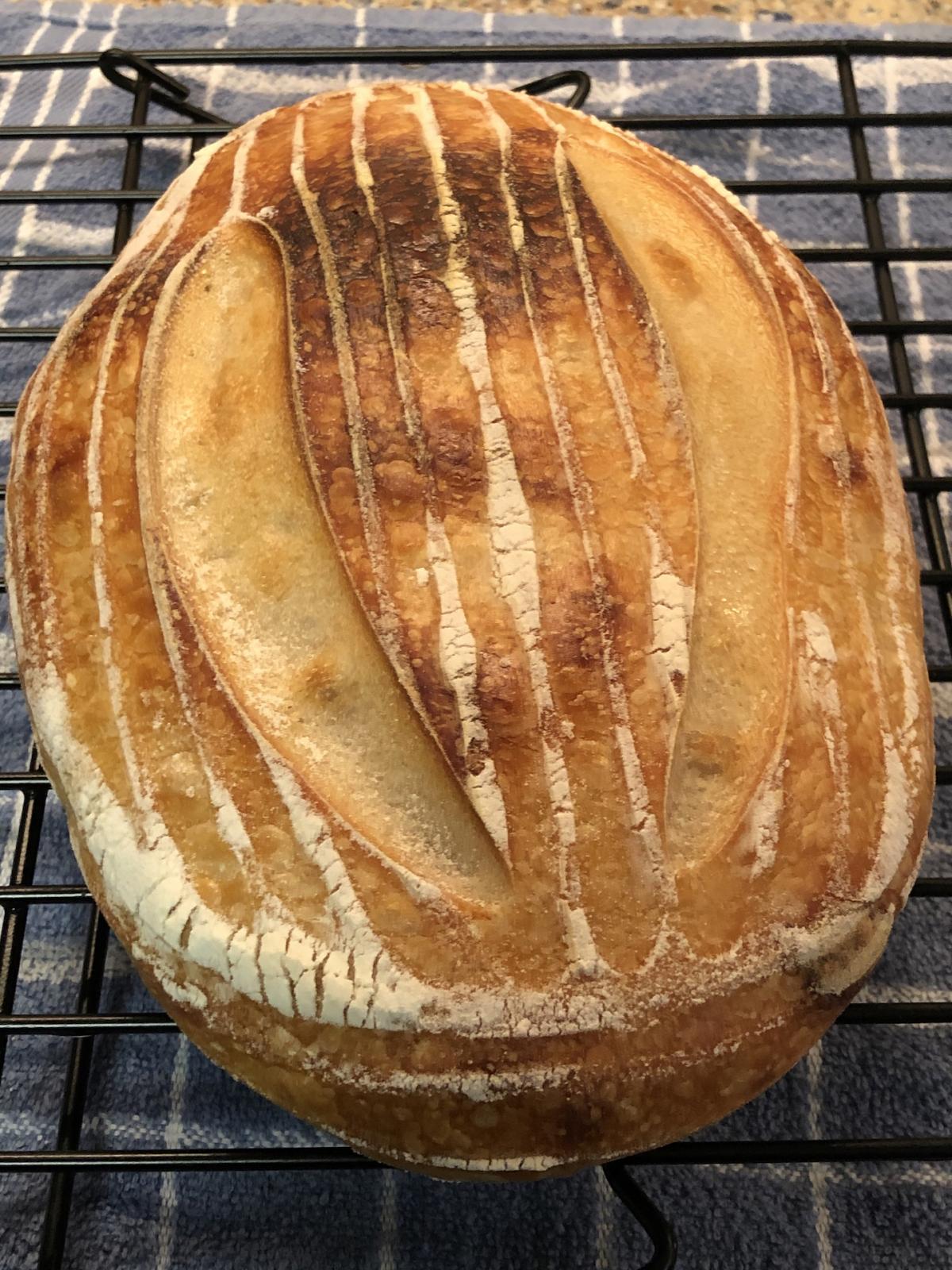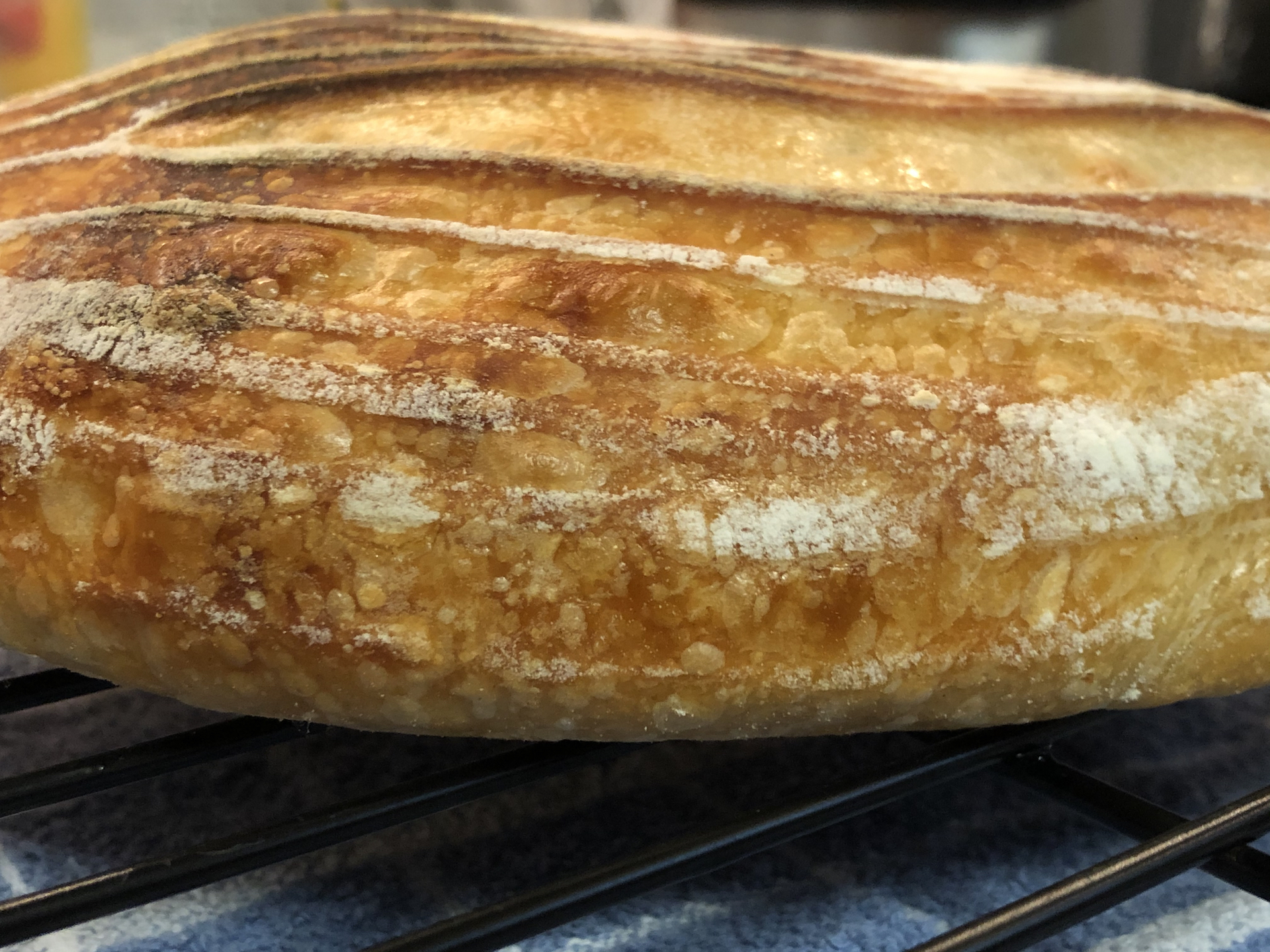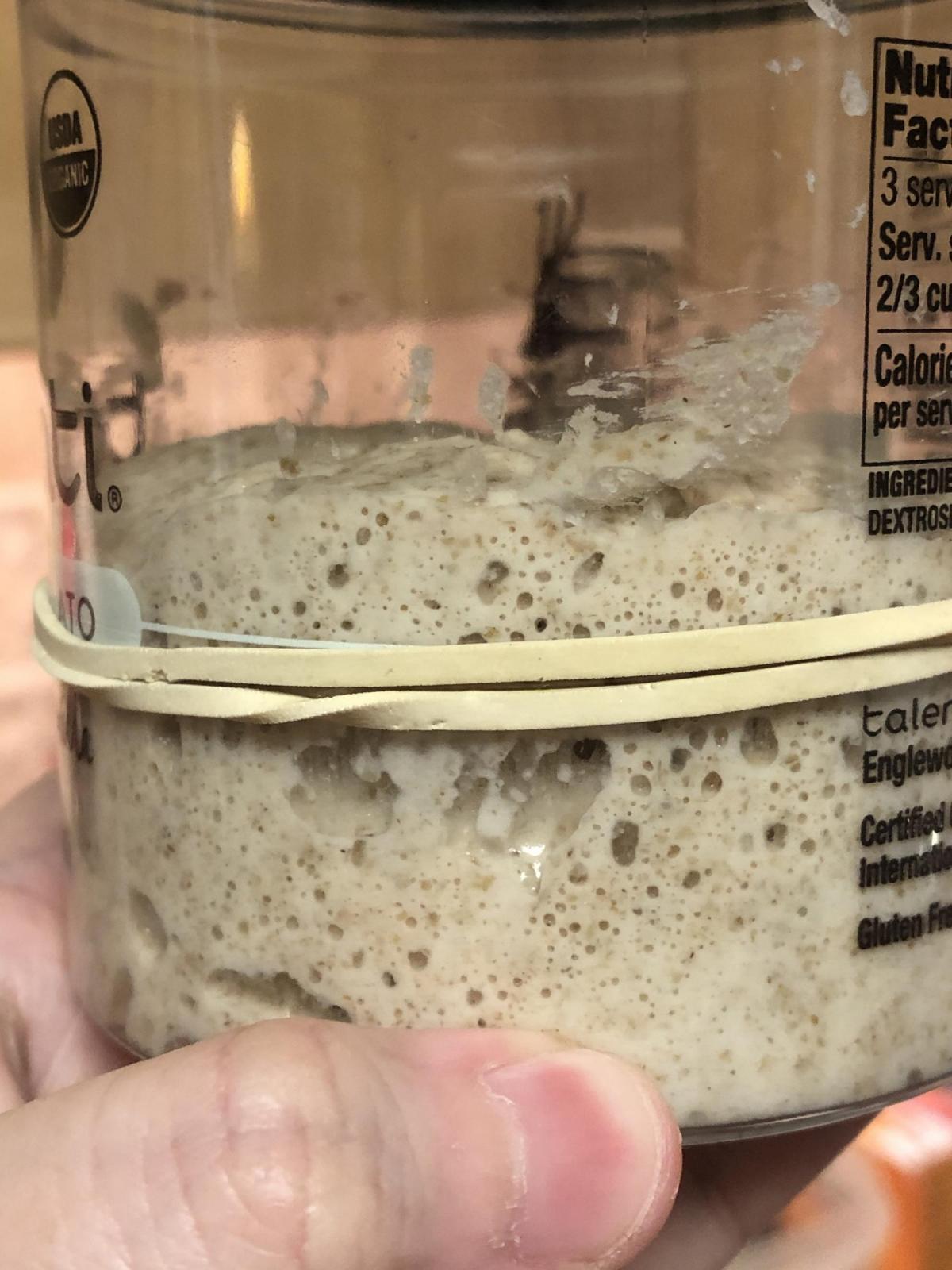Hi, I'm having trouble getting decent oven spring with sourdough, so I'm hoping some of you can help me. This is a little long. My latest loaf is the one pictured.
I've had a 100% hydration sourdough starter for about a year at this point, and it's been happily chugging along. It never gets super-foamy and bubbly, but it gets some bubbles and it seems to double eventually by about 9-10 hours. When I make sourdough bread spiked with a tiny bit of yeast, the bread rises fine and has decent oven spring. At various points over this year, I've tried feeding the starter every day or every 12 hours or even more frequently, and I cannot get it to be super-bubbly.
My problem, when I try to do a sourdough-only leavened bread, is that I can't seem to get decent oven spring at all. I get very beautiful hockey pucks, essentially. (See picture)
I don't know if this is my starter or my method or some combination.
For this latest loaf, I used the 1-2-3 method, and made a small loaf (trying not to waste flour during the pandemic), as follows:
100 g starter
200 g bottled water
290 g King Arthur artisan bread flour
10 g vital wheat gluten
7 g salt
1. I mixed the flour, water, wheat gluten, and starter together and let it autolyse for 40 minutes.
2. I added salt and kneaded it with my mixer until I had a good windowpane. (I have arthritis, so kneading by hand is hard for me.)
3. I let it rise on the counter for 5 hours, folding at 1, 2, and 3 hours.
4. I shaped and transferred to a banneton, where I let it rise in the fridge for about 16 hours.
5. I baked it at 450F with steam for 35 minutes, going straight from the fridge to the oven.
Please help--what am I doing wrong? Do I need to make a new starter? Do I need to be proofing it for a different length of time? Do I need to do something else to it? (I'm open to anything that doesn't use my hands to knead.)
Thank you all in advance. 

Jenny, 9-10 hours is a long time for a starter to double, unless the room temp is extremely cold. What would you estimate your RT?
Your starter probably needs to be built up in order to become more active. Can you get your hands on some whole Rye flour?
Danny
I agree with Danny: your starter needs help. When you feed it, what is your ratio of starter to flour and water? To put it another way, when you feed your starter, if you are combining x grams of starter, y grams of flour, and z grams of water, what are x, y, and z?
Danny: It's usually between 71-73 degrees F, but sometimes it gets a little warmer in the winter because the kitchen is close to the utility room. The last few months though, it's been in that range.
I have white rye flour, but not a ton left, and I just got 3 lbs of pumpernickel flour (which i believe is whole rye?). I also have some white whole wheat.
Jess: I've been feeding it 1:2:2, so usually about 50 grams of starter to 100 grams each of water and flour. I tried feeding it 1:3:3 the other day, and it seemed a bit happier, but still not very bubbly or foamy. I'd love to be able to feed it, and get it on a schedule that I can stick it in the fridge between feedings. Although currently, I am baking more with it than usual. Ideally, though, it'd be in the fridge, and I'd be able to use it straight from the fridge to mix into things.
I used to feed it 1:1:1, but it started smelling like acetone, even if I fed it and then immediately stashed it in the fridge (or let it sit out for an hour or two first). It'd smell fine going into the fridge, and two days later, it'd be acetone.
With the 1:2:2 feedings, if I keep it at room temperature, but miss that 9-10 hour window because I'm busy, it's usually smelling like acetone by the 12-13 hour mark. It smells fine, sort of like yogurt, before then.
Jenny, you can keep a much smaller starter. The ratio is the most important consideration. 5:10:10 is identical to 50:100:100. The only difference is you use 90g less flour each feeding. When feeding a small starter use a juice glass or some other narrow and small vessel.
Whole grain, wheat or rye, will help your starter get more active.
It is important to re-feed your starter at maturity. If you feed it too early, the microbes have not finished multiplying, so you will be diluting the population of microbes. If you allow the starter to over-mature a great deal, the starter will become weaker and the acid will increase in relationship to yeast. The ideal time to re-feed is after the starter has risen it’s highest and has just begun to recede.
You can control the time necessary for your starter to mature. Higher ratios of starter to flour will take longer to mature. Your greatest tool for timing is temperature. Warm temps will drastically shorten the time to maturity. You can also use warm (~80-90F) water to jump starter your starter. The more you cycle (feed to recede) your starter, the stronger it will become. A healthy and active starter will double in ~4 hours at 80F.
If you have time to watch your starter, feed 1:1:1 and keep at 80-84F. When it begins to recede re-feed use the same ratio and temp. But when you want your starter to over night, increase the starter to flour ratio and keep in a cool place. This way it won’t over-mature during the long night. The ratio and temps are suggestions. Watching and learning your starter will put you in control.
If you need more specific help, let us know what you feed, what temp, and how long to recede. Closeup images are helpful.
HTH,
Danny
Hi Danny, thanks so much for your help!
I switched it to a 50% rye flour, 50% AP flour feed today at 1:2:2, and I'm taking pictures every hour to try to document the progress at room temperature.
Let's say that it peaks (this is when it's fully doubled, right?) at 6 hours. Do I want to feed it at 6 hours? Or do I want to let it sit out for another hour or two before I feed it again?
Similarly, if I want to stash it in the fridge overnight (can I do that at this stage of building it up again?), do I put it into the fridge at the peak, or do I do it before/after?
I'll post pictures once it actually does something. :)
Jenny better than taking pictures every hour, take a marks-a-lot marker and mark the level and put a time on the side. The marker ink will easily wash off with soap and water.
Doubling of a starter is the bare minimum. Many starters triple and some even quadruple. We you notice that the starter has dropped below a previous level it is time to feed.
You can store in the fridge in order to hold it overnight. Best if it is matured. That way in the morning you can jump start the starter with warm water to get it going quicker. Starters are very resilient.
Looking forward to hearing your findings and seeing some closeup pictures (top/down and side view) of your matured starter.
Sorry for the delay in replying to this; I've been dutifully feeding the starter and taking pictures of it, but life has been very busy.
I've been feeding my starter with 50% rye flour and 50% AP flour.
I started out trying to feed it 1:2:2 (about 25 grams starter) the first day. It didn't do much, just a few bubbles. I watched it for 12 hours, and stuck it in the fridge. It smelled fine for most of those 12 hours. Then, I switched it to 1:1:1 for the next two days, about the same amount of starter, and it started to get some more bubbles, but the smell went to acetone really, really quickly--about 3-5 hours? One day I left it out 9 hours; I think it was close to 12 hours the next day.
At that point, life got super-busy, so it went to live in the fridge for a day.
Which brings us to today, which gives us this picture. I fed it at 1:2:2 today, because the acetone-smell was starting to really worry me.
And Bubbles! Rising above the rubberband! It took it 10 hours to get to this point. But again, it smells like acetone. It started smelling that way at about 6 hours, but it had nowhere, and I mean nowhere, this amount of bubbles in it yet.
I think the starter is definitely improving, but the acetone smell still worries me. I had some thoughts about it:
1. Is it just not mature enough yet? That maybe it died somewhat during the last year, and I'm essentially reviving it now?
2. Could it be the rye flour doing it? The acetone smell happens with AP flour alone, too, but it comes much sooner with the rye flour. My rye flour "expired" on 4/7/20, but I've had it in the freezer for awhile, and it smells non-rancid to me.
3. I think the rising time being so slow is partially due to the rye flour coming from the freezer. The bottled water and the AP flour are both still at room temp, which is still between 71-73 F.
Thanks once again for all your help! I feel like the starter is making progress, but the acetone worries me.
ETA: I can upload pictures from the other three days, if you'd like.